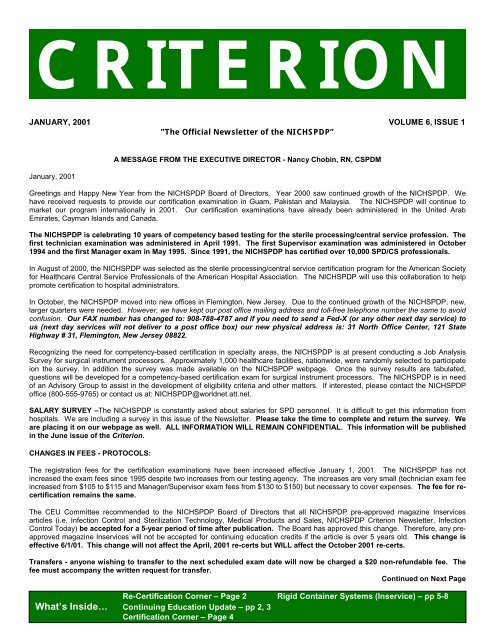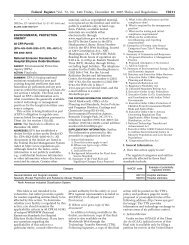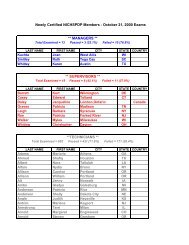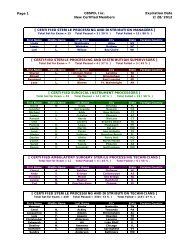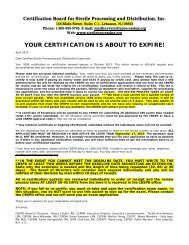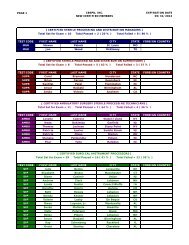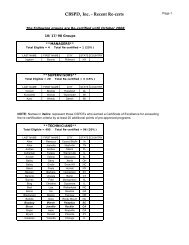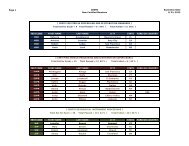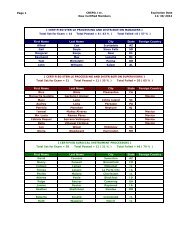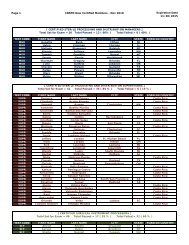Criterion - The Official CBSPD Website
Criterion - The Official CBSPD Website
Criterion - The Official CBSPD Website
You also want an ePaper? Increase the reach of your titles
YUMPU automatically turns print PDFs into web optimized ePapers that Google loves.
PAGE 3 – JANUARY 2001CRITERIONareas directly related to the examination outline for the level of certification you hold. <strong>The</strong> education must be measurable andattendance must be verified by management.Mandatory inservices required by your institution for JACHO and/or Department of Health accreditation or licensing arecovered with employment credits, these programs are not given additional credit. <strong>The</strong>se include, but are not necessarilylimited to, annual safety, infection control, etc.Inservices are to be submitted within six (6) weeks of the presentation. <strong>The</strong> CEU Committee will not review inservices over threemonths old.Going to a seminar? Verify with the sponsor of the program that they have applied for Continuing Education Credits from NICHSPDP. Ifthey have not, suggest that you would appreciate if they would. Share the application with them or give them the NICHSPDP number. Ifyou do not have success you may submit the program on your own. When you do this you must include a copy of the brochure thatdelineates the topics and times those topics are being presented.<strong>The</strong>re are some self-study journal or newsletter inservices that are available. <strong>The</strong>se will have the information that it has been peapprovedby NICHSPDP in the article CEU information. <strong>The</strong>se self-study inservices can be used once each in your five year recertificationperiod and must be used within five years of the publication date. Verification of your completion of these inservices andpost tests must be provided by management.Video’s are being reviewed for timeliness of information. Video inservices are to be submitted to the committee. If the committeemembers have not reviewed a particular video you may be asked to send the actual video for review. It will be returned to you once ithas been reviewed.Make your life easier, start maintaining a record of the contact hours and approval numbers as you get them. Start a list with the title ofthe inservice/program, date attended, NICHSPDP Approval Code Number and contact hours awarded and attach your certificates.Keep a tally of how many points you have and what you still need. This will assist you when it is time for re-certification. Remember,Technicians require 100 points over five years, 10 points per year for full time employment for a total of 50 leaving the rest to beobtained by continuing education. Supervisors and Mangers require 150 points over the five years, 5 points per year for full timeemployment for a total of 25 leaving 125 points to be earned with continuing education.College courses can be used for a maximum of 10 points per re-certification period. Adult or continuing education courses can also beused for a maximum of 5 points for Technicians, 10 points for Supervisors and Managers. Holding office or chairing a committee on alocal, state or national level can also earn points. If you do not have the Continuing Education Protocols you can request one by writingthe NICHSPDP or find it on our web site: sterileprocessing.org.We encourage all of you to begin your re-certification process early by keeping accurate records and assuring that all of the programs,inservices etc. have been reviewed by the NICHSPDP CEU Committee. Keep the certificates in one place so you do not have toscramble to find everything when you receive your re-certification notice - approximately 6 months before you are due.One other reminder: Notify NICHSPDP of any address changes so we can update our files - it is the only way we will be able to notifyyou.Enjoy your holidays and keep on learning!!JUMBLE (UNSCRAMBLE THE WORDS)DCAEOUNIT GLIANERN PTEEMOCNCE CLENXCEELEAnswers: EDUCATION; LEARNING; COMPETENCE; EXCELLENCE ♦VISIT THE NICHSPDP WEBSITE TODAY!DOWNLOAD CANDIDATE BULLETINS, RE-CERT PACKETS, NEWSLETTERS,TEST SITE FORMS, CEU PACKETS, AND MORE!YOU CAN ALSO….. GET YOUR CEU PROGRAM APPROVED ON-LINE, VIEW OUR CERTIFICATIONTEST SITES, PURCHASE STUDY MATERIAL INSTANTLY!www.sterileprocessing.org
PAGE 4 – JANUARY 2001CRITERIONCERTIFICATION CORNERBy: Nancy Chobin, R.N., CSPDM, Executive Director, NICHSPDPAre all certification programs alike? Unfortunately, no. <strong>The</strong>re are hundreds of certification programs in the United States however notall certification programs meet the recommended standards.Certification guidelines are developed by the National Organization for Competency Assurance (NOCA) which is the professionalorganization for the National Commission for Certifying Agencies (NCCA). <strong>The</strong> U.S. government established the NCCA to serve as the“watch-dog” agency for certification programs.<strong>The</strong> NOCA Guidelines ensure that certification programs are fair and unbiased. Some of the major NOCA guidelines are as follows:! <strong>The</strong> certifying body and the professional organization should be separate and distinct. <strong>The</strong> rationale for this guideline is to preventthe professional organization from applying undue influence on the certifying body. <strong>The</strong> Certification Board should have a separateBoard of Directors, by-laws and be financially independent. However, the certifying body and the professional organization shouldwork together to enhance competency in the profession.! <strong>The</strong> certification examinations are based upon a Job Analysis Survey (JAS). Legally defensible examination will have questionswhich are based upon knowledge and skills identified by the profession, not a select group of individuals. <strong>The</strong> JAS should beupdated every five years or more frequently if changes in technology dictate. Certification Boards that do not base theirexaminations on a JAS may experience challenges to their examinations. <strong>The</strong> JAS should be performed by a professional testingagency. <strong>The</strong>se agencies employ psychometric specialists who ensure questions are fair and unbiased. A JAS costsapproximately $25,000 to $35,000 excluding the costs for printing and mailing the survey. <strong>The</strong> NICHSPDP had to performseparate Job Analysis Surveys for each of its three examinations (Technician, Supervisor and Manager). <strong>The</strong> JAS is then used asthe “blue print” for the examination contents. Anyone working in the profession can submit questions (items) to the NICHSPDPItem Review Committee. <strong>The</strong> purpose of the Item Review Committee is to approve questions for the various NICHSPDP ItemBanks based upon the criteria identified in the JAS. NOCA is very specific about the membership on the Item Review Committee.Members must be currently employed in the sterile processing profession, be ethnically and geographically representative of thecandidate pool and be certified in the profession for the job title they hold (i.e. Certified Manager if in a Manager position). <strong>The</strong>NICHSPDP conducts Item Review Workshops at least annually. <strong>The</strong> cost for an Item Review Workshop is approximately $25,000,which does not include the travel and other expenses for the Item Review Members. <strong>The</strong> testing agency provides thepsychometric expertise while the Item Review Committee provides the technical expertise.In future columns, additional NOCA Guidelines will be discussed. <strong>The</strong> NICHSPDP is proud of the fact that since its inception in August1988, NICHSPDP has complied with the NOCA Guidelines.Certification helps to protect the public. A Certification Board has the responsibility to ensure the integrity of the credential and theentire process. When looking at certification programs, look at the process. Ask questions. Be an informed consumer.<strong>The</strong> next NICHSPDP examination date is April 28, 2001. Please contact the NICHSPDP office for application forms and Study Guideorder forms. Visit our new and expanded website where all our materials can be downloaded. ♦THE NICHSPDP BOARD OF DIRECTORS:NON-VOTING BOARDNancy Chobin, RN, CSPDM; Executive DirectorTeckla Ann Maresca, LPN, CSPDM; Executive Commissioner, Chairperson CEU CommitteeSue McManus, RN, CSPDM; Executive Commissioner, Test Development Committee LiaisonNora Wikander, RN, CSPDM; Executive Commissioner, CEU Review CommitteeM. Eleanor Reilly, RN, CSPDM; Board Member EmeritusPatsy Barnett, RN, CSPDT, CSPDM; Manager RepresentativeAngela Sutula, CSPDT, CCSMC; Supervisor RepresentativeGreta Boyer, CSPDT; Technician RepresentativeAugustine Shelley, CSPDT; Technician RepresentativeAngela Hollis-Dumas, CSPDT; Technician RepresentativePaul Letersky, B.A., J.D; Public MemberVOTING BOARD MEMBERS
PAGE 5 – JANUARY 2001CRITERION~APPROVED INSERVICE~Rigid Container SystemsBy: Nancy Chobin, RN, CSPDMINTRODUCTION: Rigid container systems came to US from Europe. Over the past 15 years they have become increasingly popularin US. <strong>The</strong> main reasons for their popularity include cost effectiveness, they prevent damage to instruments in storage and transit, andthey provide an effective barrier to contamination and increased storage capability.A reusable rigid container system is a container, which serves as a packaging material for items prior to, during and aftersterilization. <strong>The</strong> container can be used to contain and transport contaminated items after use. Rigid containers can be madeof ferrous metals, aluminum, various polymers or a combination of materials. When considering a container system athorough evaluation needs to be performed as with any new packaging material.Cleaning/Disassembly Recommendations - Reduction of bioburden on the containers is as essential as the soiled instruments. Inpractice, some health care facilities do not wash their containers after each use. This practice is not in accordance with AORN or AAMI.Containers should be washed after each use.Components of a container include but are not limited to:Filters - When using a system with removable filters, the filter holder should be removed to disengage the filter, which is thendiscarded. Valves – some systems have valve-type closures. Users should always follow manufacturer’s instructions for removal anddisassembly. Interior baskets – surgical instruments can be processed inside the interior basket or removed and placed insideanother basket. Labeling- Reusable labeling systems may be affixed to the exterior of the container and the inner basket for easyidentification. Process Indicators, disposable labels and disposable locks – all should be removed prior to cleaning. Dividers andsorting pins – may have to be removed for cleaning if it is determined they will interfere with proper cleaning. Decontamination andCleaning Agents – As with any product, always follow the manufacturer’s instructions for processing. Containers can becleaned manually or mechanically. Selection and use of correct detergents is essential; anodized aluminum and someplastics require the use of neutral pH detergents. This is especially important if the containers will be processed through a cartwasher, which traditionally use high alkaline detergents). After cleaning, all components should be inspected before reuse.Preparation and Assembly – As with any packaging system, inspection of the packaging should be performed before use. With rigidcontainers, inspect all surfaces of the container system for cleanliness, check to make sure that sealing surfaces are intact, inspectgaskets for nicks and that they are securely fastened, and that the filter retainer mechanisms is secure.Configuration of sets – <strong>The</strong>re is no magic number in terms of weight of sets. Previously there were recommendations from AORNthat the maximum weight of a surgical instrument set was 16 pounds (excluding Orthopedic sets). However, the currentrecommendation is that the weight of sets be based upon the employee’s ability to properly lift and handle container as well as thesterilizer’s ability to dry the set by the end of the cycle. All sterilizers are unique and therefore, it is recommended that validation fordrying capability be performed in each sterilizer. <strong>The</strong> largest sets sterilized (i.e. Orthopedic, Open-Heart) should be sterilized in aroutine cycle. At the completion of the cycle, and after cooling, the set should be opened and inspected for any signs of moisture orvisible water inside the container. (NOTE: This testing should be performed on weekends or at such time when the tray will not beneeded for patient care). This testing should be performed in each steam sterilizer.If the sets are found to be wet or have visible moisture, the drying time may have to be extended and if that does not resolve theproblem, the set may have to be reconfigured. Sometimes the distribution of the instruments on the set impacts the sterilizer’s ability todry the condensate that forms. If re-distribution of the set does not resolve the problem, the set may have to be re-configured intosmaller sets. Remember, the total weight and density must be considered. Sometimes, pre-conditioning the load helps with moistureproblems. To pre-condition the steam load, place the load inside the sterilizer, close the door but do not engage the cycle. Allow theload to gradually heat-up in the chamber for approximately 10 minutes. <strong>The</strong>n start the cycle.Assembly of instruments inside a rigid container is similar to any wrapped set. All jointed instruments should be open and/ordisassembled; items with lumens should be flushed with sterile distilled water immediately before sterilization.<strong>The</strong> use of surgical towels or other absorbent material inside trays is another confusing issue. It is recommended to follow thecontainer manufacturer’s instructions. In some cases, use of a surgical towel may be helpful in the drying process especially with verydense sets. Also, if inner baskets have large openings in the wire, a towel can prevent instruments from falling through the wire.However use of rolled towels is not recommended.Only those accessories recommended by the manufacturer should be used. When preparing complex instruments – (i.e. air powereddrills/multi-part/multi-hinged devices) always follow the device manufacturer’s instructions for processing. When complex or specialtyitems are mixed with routine instruments you may have to validate sterilization/drying.Continued on Page 6
NOMINATION FORM – NICHSPDP / BOARD MEMBER CONTESTPLEASE PRINT ALL INFORMATION:NAME: _______________________________ ______________________________Last Name First NameHOME ADDRESS: ________________________________________________________StreetPO Box or Apt. Number(Please specify)___________________________________________________ ________________ _____________________City State Zip CodeHOME TELEPHONE: _____________________________________________________(Area Code)WORK PHONE: _________________________________________________________(Area Code)SOCIAL SECURITY NUMBER: __________ - ________ - ___________PLACE OF EMPLOYMENT: ____________________________________________________DEPARTMENT: ________________________________TITLE OF POSITION: ___________________________WORK ADDRESS: ______________________________________________________________CITY: ____________________________ ST:____________ZIP CODE:________________DATE CERTIFIED: _________________Please attach the following to this Application:1. A statement why you would like to be elected to the NICHSPDP Board2. A letter from your Supervisor, on your employer’s letterhead verifying that if you should winthe election you will be given the time (your own time or employer time) to attend annualBoard of Directors Meetings.ALL NOMINATIONS MUST BE RECEIVED BY MAY 15, 2001. YOU ALSO MUST MAKE SURE THAT YOUINCLUDE THIS FORM ALONG WITH ITEM #’s 1 & 2 FROM ABOVE. IF ANYTHING IS MISSING, YOURNOMINATION WILL NOT BE ACCEPTED.
NICHSPDP SALARY SURVEY – WINTER 2001Copyright – NICHSPDP – 2001 – All Rights ReservedSTATE YOU LIVE IN:_____________________________Please take a few minutes to complete this survey. <strong>The</strong> NICHSPDP will publish the results in our June-July issueof the <strong>Criterion</strong>.1. How long have you been certified? _____________ years.2. Are you certified as a (check all that apply):_______ Technician _______Supervisor _______Manager3. Does your hospital require certification for sterile processing technicians? ___Yes ___No4. When you became certified, did you receive a salary increase? ___Yes ___No5. If you received an increase, what amount was the increase ? Please be specific:______ cents per hour___________dollars per hour ____________dollars per yearother (please specify):______________________________________________________________________6. What was the main reason you became certified?___required by my hospital___Self personal/professional growthother (specify):____________________________________________________________________________7. When you became certified, did your job title change? ___Yes ___No8. If yes, what was your title BEFORE you became certified?__________________________________________9. What was your title AFTER you became certified?_________________________________________________10. Does your facility permit you to use your credentialling initials after your name? ___Yes ___No11. Do you feel that NICHSPDP certification has made a difference in your work performance? ___Yes ___No12. If so, how did certification make a difference?____________________________________________________13. Have you re-certified yet? ___Yes ___No14. If you answered Yes, how did you re-certify? ___continuing education/work ___re-examination15. Do you have access to a computer at home? ___Yes ___No16. Do you have access to a computer at work? ___Yes ___No17. Have you visited the NICHSPDP <strong>Website</strong> at: www.sterileprocessing.org? ___Yes ___NoPlease share any comments with the NICHSPDP here:PLEASE RETURN THE COMPLETED SURVEY TO: NICHSPDP, PO Box 558, Annandale, NJ 08801 – ALLCOMPLETED SURVEYS MUST BED RECEIVED NO LATER THAN 5/15/01.
PAGE 7 – JANUARY 2001CRITERIONRIGID CONTAINER QUIZNOTE TO INSTRUCTOR: After providing the Inservice, give and grade the post test. <strong>The</strong> NICHSPDP requires a passing grade of 70or better to receive continuing education credit for this Inservice. Upon successful completion of the post test, provide eachemployee with a certificate or other form of verification of passing the post test. DO NOT SEND THE INSERVICE OR TEST TOTHE NICHSPDP. <strong>The</strong> certificate should remain in the employees' file until this documentation is requested for re-certification. ThisInservice has been awarded (1) contact hour towards re-certification.MULTIPLE CHOICE:1. Biological monitoring of rigid container systems is performed using aA) Bowie-Dick test packB) Traditional biological test packC) Container test packD) Biological vial inside a syringe2. Placement of chemical indicators inside rigid containers should beA) in the geometric center of the basketB) on the left side of the basketC) on the right side of the basketD) in two opposite corners of the basket3. After each use, rigid containers should beA) completely disassembled and washedB) washed only if used to transport soiled instrumentsC) washed only if brought into the OR roomD) wiped out with a hospital approved disinfectant4. Most rigid container manufacturers recommend detergents which areA) alkalineB) acidC) neutralD) organic5. Pre-conditioning of a steam sterilizer load refers toA) getting the load ready for sterilizationB) packaging the load for sterilizationC) setting the temperature at a higher settingD) placing the load inside the sterilizer to warm up first6. Which of the follow is not a component of a rigid container set?A) gasketB) autoclave tapeC) filterD) security mechanism7. Security locks are used to distinguish if the container has beenA) openedB) sterilizedC) washedD) disinfectedContinued on Next Page
PAGE 8 – JANUARYCRITERION8. Rigid Containers usually can be stacked in a steam sterilizer to a height ofA) 6”B) 8”C) 10”D) as recommended by the container manufacturer9. All of the following can affect drying of rigid container except:A) size of the containerB) density of the instrumentsC) configuration of the setD) loading of the sterilizer10. Rigid container sets can be sterilized in a mixed sterilizer load as long asA) there are no linen packs in the loadB) linen packs are placed on the shelf beneath the containersC) basins sets are not included in the loadD) linen packs are placed on the shelf above the containers


